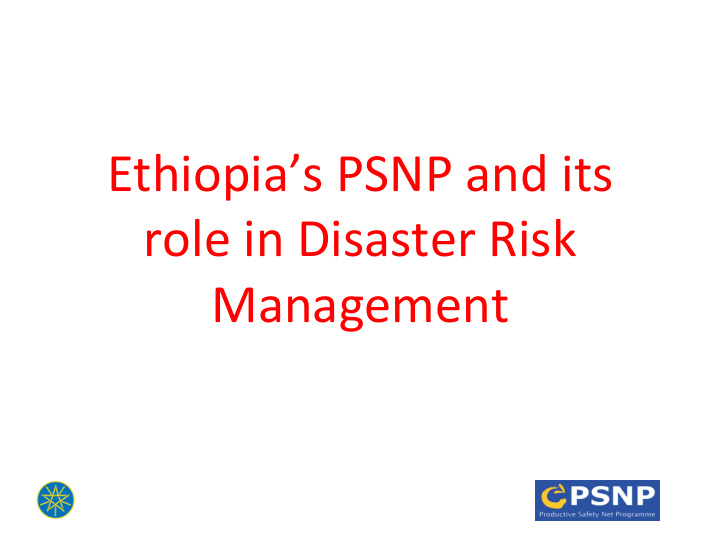



Ethiopia’s PSNP and its role in Disaster Risk Management
What is the PSNP ? An instrument that aims to contribute to implementation of Ethiopia’s GTP and four key Government policies/strategies (SP, DRM, NNP and CRGE). A Safety Net that provides transfers to chronically & transitory food insecure households, strengthens livelihoods and builds community assets.
PSNP IV Goal &Outcome Goal: Resilience to shocks and livelihoods enhanced and food security and nutrition improved for rural households vulnerable to food security Outcome: Enhanced participation in improved rural safety net, livelihood and nutrition services by food insecure female/male headed households
PSNP Outputs Five outputs of the program: 1. Prioritized instruments and tools in place to support an effective system for social protection and disaster risk management (incl. work on MIS, registry, targeting) 2. Appropriate, timely and accessible transfers (cash and/or food) received by male an female clients (in response to chronic and transitory need). 3. Sustainable community assets built up and access to social services enhanced.
PSNP Outputs (cont’d) 4. Clients’ livelihood opportunities facilitated through three pathways: crop and livestock, off ‐ farm income generation and employment 5. Effective management and operational processes in place to manage the program
Percolation ponds for water harvesting, recharging underground water table
Check dams for water harvesting
PSNP Scale and Scope Current phase of PSNP is designed to be able to cover 10 million clients (8.3 mln chronic and 1.7 mln transitory food insecure clients) PSNP will support a total of 411 districts in six regions. PSNP will construct over 45000 community based infrastructure projects a year aiming to improve community resilience. PSNP will be able to graduate a million people into food security every year.
PSNP IV Scale and Scope cont’d As clients graduate, new clients will be added on a needs basis as long as there are unmet needs. Program will focus on food insecurity and poverty as key criteria for selection of clients. However, tailored support services will be offered to groups with specific needs (elderly, youth, pregnant and lactating women etc.) Budget estimated at 3.6 bln USD for 5 years
HOW CAN THE PSNP CONTRIBUTE TO RESPONSE AND RESILIENCE? SP CCA DRM
PSNP plays a Key Role 11 Protecting the poor and vulnerable from disaster impacts and supporting their recovery Enhancing the ability of the poor and vulnerable to withstand disaster impacts and adapt to new and increased risks as a result of climate change
PSNP – A Key Role Predictable cash transfers can mitigate the vulnerability of the chronic poor who will be increasingly exposed to climate ‐ related shocks By providing an income while they seek ways to adapt and diversify their livelihoods Formation of informal savings groups Additionally, SP measures can help increase capacity and resilience by supporting community assets, agricultural activities, environmental conservation, etc (e.g. Supporting small irrigation, aforrestation, etcc.)
PSNP and DRM Resource Continuum PSNP is part of the continuum of support for vulnerable people PSNP contingency budget is one tool in the DRM toolkit, allowing an early response through a temporary expansion of the PSNP: Funding Source Trigger Implementation Responsibility Woreda Contingency Ongoing EW in line PSNP areas; FSCD/EWRD (5% annual core program budget) with DRM ‐ SPIF Federal Contingency Annual Needs PSNP and Non PSNP areas in (11% of annual core program budget) Assessment (HRD)/ PSNP regions; FSCD/EWRD Early Warning Info Humanitarian Response Process Annual Needs (Annual fundraising) Assessment (HRD)/ FSCD, EWRD + hum actors Early Warning Info
14 Key Features Continuum One joint assessment of transitory need (tools: EW info and seasonal assessments). One response plan to cover transitory need. One comprehensive financing plan for the response plan (PSNP RFM one source of funding). One decision making structure
Joint Assessment of transitory need (seasonal) Humanitarian PSNP federal Annual response assistance: contingency and financing Various budget plan funding sources Implementation response through ERWD/FSCD and non state actors
Challenges and opportunities Bringing SP, DRM & CCA agencies together to learn from each other and identify programming opportunities Eg in the Ethiopian context there are many different actors with different mandates .. We are therefore in the process of setting up a dedicated coordination agency! Linking ad ‐ hoc disaster relief/recovery support with more permanent SP/SSN systems
Thank you
Recommend
More recommend